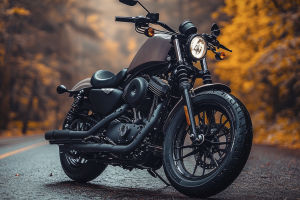
When it comes to choosing the right motorcycle, it's not just about picking one that looks cool. We need to consider several factors to ensure we make the best decision for our needs and riding style.
Whether you're a seasoned rider or a beginner, here's a guide to help us choose the perfect motorcycle!
1. Purpose of the Motorcycle
The first thing we should think about is what we plan to use the motorcycle for. Are we looking for a bike to get us around the city every day? Or are we after something for leisurely weekend rides or even professional riding? Understanding the purpose of our motorcycle will help narrow down our choices. For example, a commuter bike will differ from a sportbike or a cruiser in terms of features and performance.
2. Budget
It's important to set a budget that works for us. Motorcycles come in a wide range of prices, from affordable entry-level models to high-end premium bikes. We should be realistic about what we can spend and consider not just the purchase price but also long-term costs such as maintenance, insurance, and fuel efficiency. Having a clear budget in mind will help us make a well-informed decision without breaking the bank.
3. Brand
When choosing a motorcycle, opting for a reputable brand can give us peace of mind about the quality and reliability of the bike. Well-known brands tend to offer excellent after-sales support, spare parts availability, and warranties. It's worth considering brands that have a strong reputation in the industry, such as Yamaha, Ducati, Honda, or Harley-Davidson, to ensure a great overall experience.
4. Performance
Performance is key when selecting a motorcycle. Depending on how we intend to use it, we should focus on engine type, displacement, power output, and other performance parameters. For daily commutes, a lower displacement engine might be sufficient, but for long-distance touring or high-speed riding, we might need something with more power. It's essential to find a balance between performance and comfort based on our needs.
5. Safety Features
We can never compromise on safety, especially when riding on the road. Safety features like ABS (anti-lock braking system), electronic stability control, and traction control are important aspects to consider. These features help prevent accidents and give us better control of the bike, especially in adverse weather or road conditions. Making sure our bike has these advanced safety systems will make our ride much safer.
6. Appearance
Let's face it – we all want our bike to look good! While performance and safety are essential, the appearance of the motorcycle also plays a role in our decision. Whether it's a sleek, modern design or a classic look, the visual appeal of the bike should match our style and taste. After all, it's something we'll be spending a lot of time with, so it's important that we like how it looks.
7. Test Ride
One of the best ways to determine if a motorcycle is the right fit for us is to take it for a test ride. This will allow us to experience how the bike handles, its comfort, and its overall performance. A test ride also gives us the chance to check how well the bike fits us in terms of height, reach, and comfort. After all, it's important to feel comfortable and confident when riding, so don't skip this step!
Performance Parameters to Consider
Now that we've covered the basics of choosing a motorcycle, let's dive into the specific performance parameters that will help us choose the right bike.
1. Engine Displacement
The displacement of a motorcycle engine plays a major role in its overall performance. Smaller engines, typically in the 125cc to 250cc range, are ideal for city commuting and light rides. If we plan to go on longer trips or ride at higher speeds, opting for a bike with a larger engine, such as 500cc to 1000cc, will give us the power we need.
2. Power Output
The power output, measured in horsepower, affects a bike's acceleration and top speed. If we're looking for a bike that offers thrilling speed and quick acceleration, we should choose a motorcycle with higher horsepower. But remember, with more power comes more responsibility, and we'll need to ensure that we're skilled enough to handle a high-performance machine safely.
3. Suspension System
The suspension system of a motorcycle affects how comfortable the ride will be. Different types of suspensions offer varying levels of comfort depending on the type of terrain we'll be riding on. If we're mostly riding on smooth, paved roads, a standard suspension should be sufficient. However, if we plan on venturing off-road, we'll need a more advanced suspension system to handle bumps and rough terrain.
4. Safety Features
As mentioned earlier, safety should be a top priority. Features like ABS, traction control, and electronic stability systems ensure that we have a safe and stable ride, particularly in difficult conditions. These systems can prevent accidents and give us more confidence on the road.
5. Fuel Efficiency
Motorcycle fuel efficiency is an important consideration, especially if we're planning to use it for daily commuting. A more fuel-efficient bike will help us save money on gas and reduce our environmental impact. Depending on the bike's engine size and design, we can expect different fuel consumption rates. For city commuting, a smaller engine might be the better choice, as it will consume less fuel.
Choosing the right motorcycle is an exciting decision, and we hope this guide helps us make the best choice for our needs. Whether we're after something for everyday commuting or a high-performance machine for adventure, taking into account factors like purpose, budget, brand, performance, and safety will help ensure that we end up with a motorcycle that fits perfectly into our life. So, are you ready to hit the road on your new ride?
